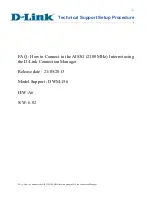
scope, and / or global settings.
C) If using the PXE protocol,
and not using
the DHCP service to
provide the filename of the bootstrap program in its initial reply,
please provide configuration details of the proxy DHCP and BINL
service being used on the Boot Server. If a workstation
management application is in use, refer to the vendor
documentation for instructions and support regarding proper setup,
configuration and image file creation.
3) Copies of all TFTP log files (if available) compressed and attached to
e-mail. If TFTP has not generated log files, enable logging, re-
create the problem and send the log file results. Describe TFTP
settings: if transmit is set to secure or non-secure, the full path to
image files used, etc. Indicate the name and version of the TFTP
server used.
4) The version and service pack level of the server being used. In
addition, please provide the IP address (of each NIC), subnet mask,
and services/daemons running at the time of failure. A list of NT
services can be obtained by running the command NET START and
redirecting the command output to a text file. UNIX daemons can
be listed by running PS -AUX and redirecting the output.
RPL (NT Remoteboot Service):
If the end user has an unsupported NIC (i.e. there is no boot block and
configuration record for the adapter), then refer to "Creating
Remoteboot Configurations for New Adapters" in Chapter 15,
Networking Guide, Windows NT 4.0 Resource Kit or Chapter 8,
Installation Guide, Windows NT 3.5x manuals.
If attempts have already been made to configure the adapter using the
above resources, or if the adapter is one of those already supported by
the Remoteboot service, then provide the following:
1) From a command prompt, path to
\%SYSTEMROOT%\RPL
. Run
the following command and send the results:
DIR /S >
RPLDIR.TXT
. This is needed to check for path naming
inconsistencies in boot block and configuration records.
90














































